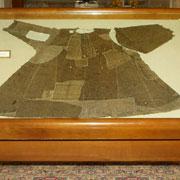 One of the robes said to have belonged to St Francis of Assisi.Wikipedia
One of the robes said to have belonged to St Francis of Assisi.WikipediaFour Franciscan churches in central Italy claim that they each hold a habit of St Francis of Assisi, the friar who founded the Franciscan order in the early 1200s. Carbon dating has now substantiated one of those claims, and helped to shore up a story from the church's history many centuries later.
In Italy, religious relics are venerated by millions of Catholics who believe that God works miracles through them, or who simply fear them. Every year more than three million visitors come to the major shrine of St Francis, a basilica in Assisi that hosts famous frescoes depicting the saint's life, and one of the habits said to have belonged to the saint. A second robe is held at the Sanctuary of La Verna near Arezzo in Tuscany; a third at the Basilica of the Holy Cross in Florence; and a fourth at the Basilica of Cortona near Arezzo.
A branch of the Franciscan order in Tuscany, which rules only the churches in Florence and Cortona (different parts of the Franciscan order oversee the other two), were keen to see whether the two robes they held were real. They were particularly interested in the one at Cortona, said to have been brought there by Brother Elia Bombarone, the saint's first successor. In 2003, on the 750th anniversary of Brother Elia's death, the monks started to seek evidence to support the story of Brother Elia's role.
So the order asked Italian nuclear scientists to check up on the habits. "The request came directly from the Franciscan order," says Pier Andrea Mandò of the Italian National Institute of Nuclear Physics in Florence. He and his team took a few tiny samples from the robes and used a standard technique known as accelerator mass spectrometry (AMS) to measure the amount of isotope carbon-14 in the cloth.
A good date
The result, presented this week at the European Conference on Accelerators in Applied Research and Technology in Florence, shows that the robe kept in the Basilica of the Holy Cross is 100 years too young to have belonged to St Francis. But the one held in the Basilica of Cortona dates to between 1155 AD and 1225 AD, roughly contemporary with the saint.
This robe is kept together with a mortuary pillow and a Gospel Book, which are also attributed to St Francis. Carbon dating of the pillow shows that it is also contemporary with the saint's life. Palaeographic experts at the University of Siena say that the handwriting in the Gospel Book is in the same style used during the saint's period.
The Franciscan order says they are happy that the results seem to confirm Brother Elia's acts. Father Padre Antonio Di Marcantonio, leader of the Tuscan order, says he is not deeply concerned by the results of the first robe; its white cord belt turns out to be contemporary with St Francis, according to the physicists' work, so the power of the Florence relic is still intact, he says.
Hostile debate
Investigations of relics are not unusual in Europe, although they can give rise to much controversy. "Many relics have been recognised as fake, such as the arm of St Anthony of Padua, which turned out to be a stag's penis on examination," says Antonio Lombatti, a researcher of medieval church history at the National History Institute in Parma, Italy.
Particularly hostile debates between scientists and men of faith followed the 1988 radiocarbon dating of the Shroud of Turin — a linen cloth bearing the image of a man that many think is the imprint of Jesus. The research dated it at least from 1260 AD. (See column '"To know a veil": http://www.nature.com/news/2005/050124/full/050124-17.html').
ADVERTISEMENT
Lombatti says that more modern techniques could help to confirm this late date. "But the Church has more or less closed its doors to science on the shroud and many other relics," he says.
Mandò says that he has no interest in re-dating the shroud. "There are too many religious and political implications," he says.
Visit our newsblog to read and post comments about this story.
